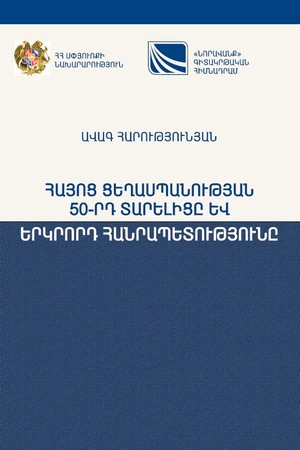 06.11.2015
06.11.2015
THE 50TH ANNIVERSARY OF THE ARMENIAN GENOCIDE AND THE SECOND REPUBLIC
Avag Harutyunyan
First time ever in Armenian historiography the historical-political process of the commemoration of the 50th anniversary of the Armenian Genocide, the Communist Party/government events and popular rallies, the role of Mother See of Holy Etchmiadzin and the Union of Writers, expansion of Armenia-Diaspora ties and establishment of the Committee for Diaspora, as well as reintroduction of the Artsakh issue and details of commemoration of the Armenian Genocide in 1970-80s are presented and analyzed in a book with wide and comprehensive use of archive sources, periodicals and literature.
The book is intended for wide readership.
PREFACE
As prominent writer, publicist and civic activist Vardges Petrosyan had once aptly remarked: “For 45 years from 1920 to 1965 every April 24 we did not even have the right to… grieve. Understandably, all of this insulted our national pride, year by year straining the tension spring of our national patience and dignity. And in 1965, on the day of the Great Genocide 50th anniversary, that spring broke1.”
The commemoration of the 50th anniversary of Genocide was mostly prompted by two factors: unification of Diaspora communities around topic of the Genocide and around the only homeland they had – the Soviet Armenia, on one hand, and the certain “liberal” atmosphere created in the USSR after Stalin’s death, on the other. To tell the whole truth, it also has to be admitted that had Soviet Armenia not been led by a man of devout patriotism and political courage like Yakov Zarobyan in this particular period, the events would have at best turned into the usual perfunctory Soviet commemorations.
If he did not care and paid little attention to such an un-Soviet and non-communist issue, which at the time would be considered understandable and routine, he would have kept his job and the construction of Armenian Genocide memorial would have been delayed for an indefinite time. After 1965, the victorious march of conservatism led by Suslov began in the USSR, turning into the so-called “years of stagnation”. It can be recalled that a veil of silence and oblivion was cast on the 20th, 30th, and 40th anniversaries of the Armenian Genocide, whereas the 60th and 70th anniversaries were mostly “commemorated” in a formal and perfunctory manner.
1 See: Պետրոսյան Վ., Մեր ժողովուրդը իմն է` ինչպես… իմ վիշտը, Ե., 2003, էջ 133:


